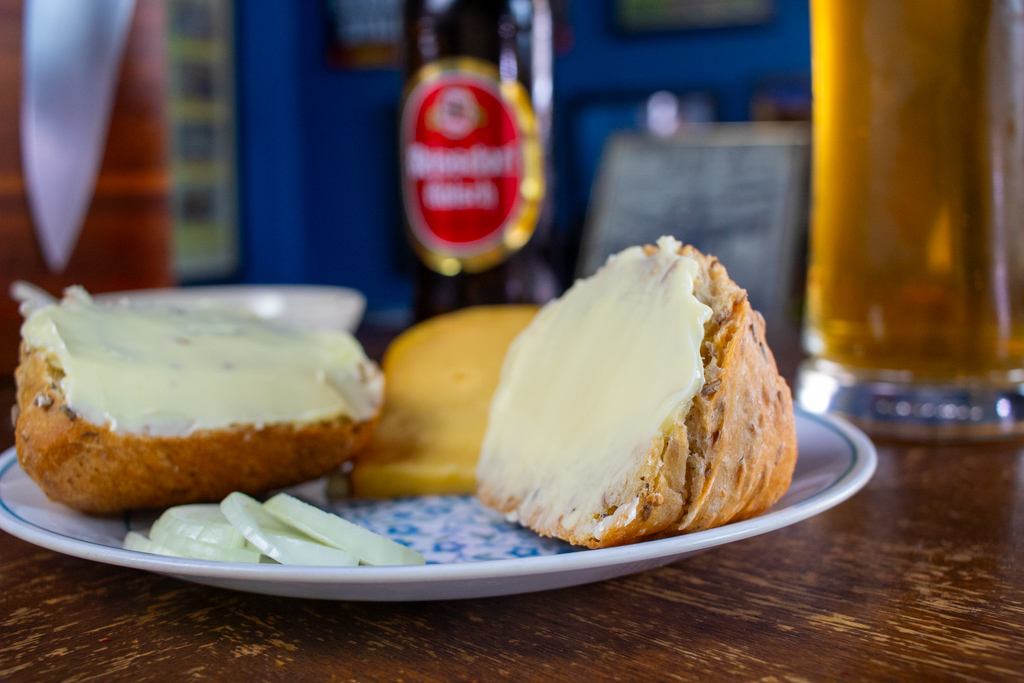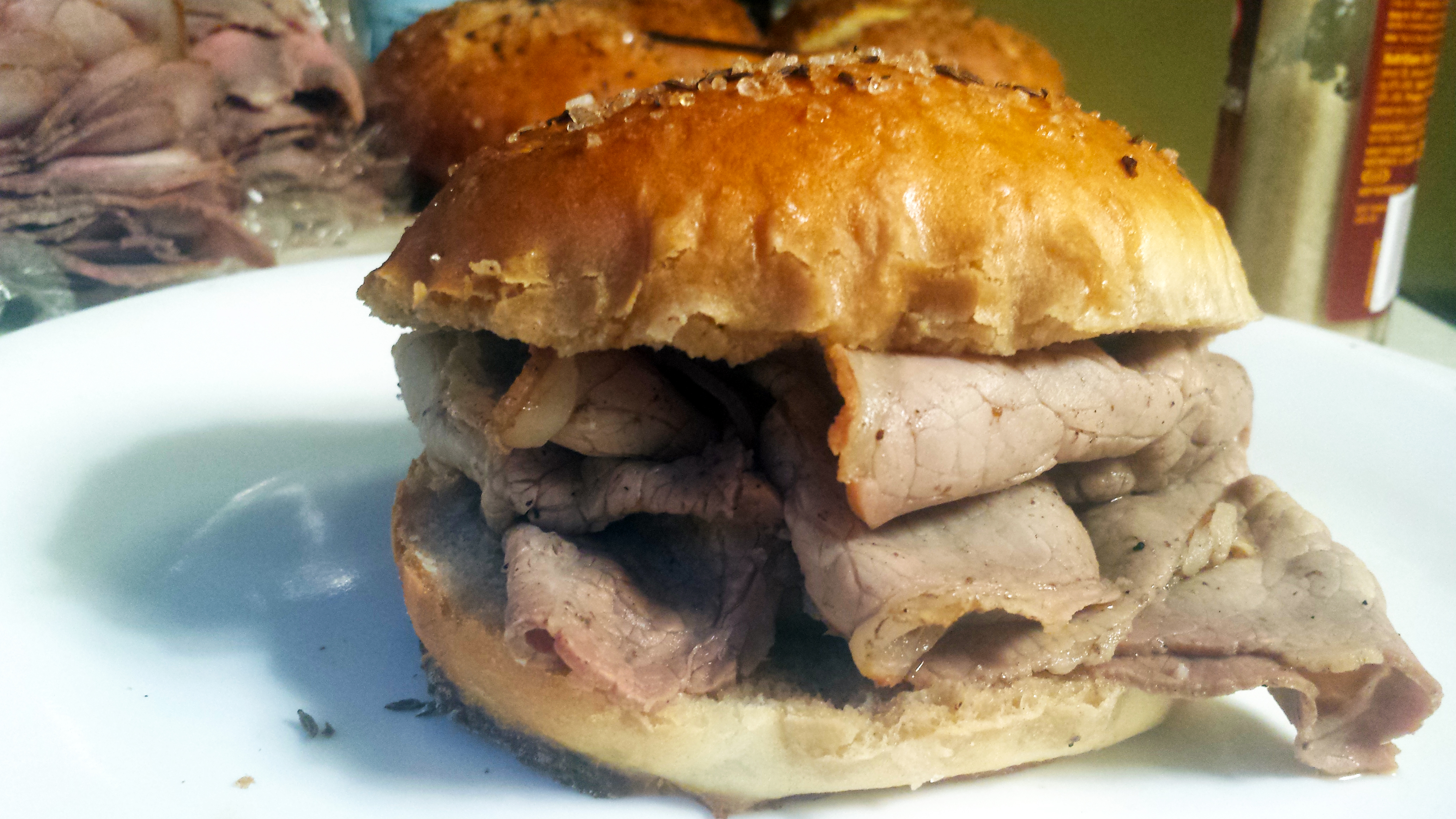Halve Hahn, Cologne’s Half-Cocked Cheese Sandwich

Halve Hahn is a German drinking snack, half of a rye bread roll served with butter, sharp mustard, a thick slab of cheese, and sliced onions as a sort of deconstructed sandwich. Native to Cologne, or Köln in German, it’s generally enjoyed with a Kölsch, the local style of beer, top-fermented like an ale but cold-conditioned like a lager, golden and crisp, fruity and dry, a delicious quaff. Nearby Düsseldorf, around 40 kilometers (25 miles) away, also claims Halve Hahn as their own local delicacy, pairing it instead with Altbier, the local style of beer, top-fermanted like an ale but cold-conditioned like a lager, copper-colored and hoppy, malty and nutty. In Düsseldorf they may add gherkins to the plate, and it will be served with a ceramic crock of the local mustard, hot, brown, and sweet.
There are a number of origin theories for the name “Halve Hahn”–you can order a similar plate just about anywhere in Germany by simply asking for a Käsebrötchen or Käsesemmel or whatever the local term for a bread roll with cheese is. Halve Hahn, on the other hand, translates directly as “half rooster.” It’s an unusual name for a deconstructed cheese sandwich, and the various apocryphal origin stories for it–mostly placing this origin in the latter half of the 19th Century–sound like this:
- A young man threw a birthday party for himself telling each guest they would get a half rooster to eat, but had the waiter serve them cheese sandwiches instead
- A bridal party wished to order half roosters for their wedding guests but were short on funds. When the innkeeper tallied up how much they had, he determined that it was enough for a cheese sandwich for each guest.
- A guest was served a whole cheese sandwich but it was too much for them, and they cried, “but I only want to have half!” In the dialect of that place and time, “Halve haben” (have half) was shortened to “Halve han.” The pun was noted and the name stuck.
- During the war (the Franco-Prussian War I assume) bread was expensive but cheese was cheap, and somehow this led to “half a han” meaning a cheese sandwich. I suppose it makes more sense in German.
- In Köln, waiters are called Köbes (a form of the name Jakob) for some reason. I am uncertain why this detail is relevant but I had to look up the meaning of the term “Köbe” so I’m sharing it. One theory suggests that half a cheese sandwich was a quick meal for a Köbe while they were waiting for a beer to be poured, “Hahn” being another word for a beer tap.
The cheese served with a Halve Hahn is generally a moderately-aged Gouda, though one source I read stated that in Düsseldorf, Mainzerkäse might be used instead, a sort of young hand-rolled cheese. The rye bread rolls I’ve seen being used have generally been a darker rye. One of them I saw was creased down the middle in such a way that it could be easily broken in half, much like a Chilean marraqueta. For this post, I have scraped together what I could but my level of authenticity–inasmuch as authenticity is worth that is, I’ve said before that it’s a moving target–will not be up to my usual standard. The rye bread roll is a nutty, seeded, light rye from a local bakery. I bought Gouda–smoked Gouda, as the semi-aged kind can be difficult to find sometimes–and a farmer’s cheese that I thought might bear a passing similarity to the Mainz, in flavor if not in appearance. I bought sharp German mustard–in a tube rather than a stoneware crock–and a big beautiful yellow onion. And I bought Kölsch to drink with it all, which I thought would pair better with a cheese, mustard, and onion sandwich than an Altbier would.








So I assembled my Halve Hahns, one with the milder farmers cheese





and one with the more assertive smoked Gouda.




And I have nothing to complain about with either of them. The sharp mustard-inna-tube has a bit more bite than a typical yellow American mustard (though not as much as, say, Coleman’s English mustard) but between it and the sliced onion there’s enough of a pungent, acidic punch to cut through the richness of butter and a thick slice of cheese. The rye roll is hearty, seeded not with caraway but with flax, sesame, sunflower seeds, and with whole grains, a Vollkornbrötchen that was well suited to this use despite not being precisely what might be served in Cologne. The farmers cheese is clean in flavor, bright and a little sour, while the smoked gouda is a bit firmer, nutty and salty and smoky yet not overpowering.
But the meal was missing something…






I finally managed to find an aged Gouda–though aged more fully than what is generally served with Halve Hahn, a true vintage Gouda–and opened the Kölsch I’d bought to celebrate. This cheese was too dense, too firm to slice thickly and place on bread, lending itself better to shaving bits off with a planing type of slicer. It was intensely nutty, with a rich savory flavor like a Parmesan and crystals throughout like a long-aged cheddar. The thinness of the slices was more than made up for by the potency of the cheese. This gouda wanted to be the star of the show rather than an ensemble player, which did not lend itself to as balanced an experience as the other cheeses.

But really, who can complain about an afternoon at the bar (even a home bar), drinking Kölsch by the half-liter, snacking on good, hearty bread with some cheese, mustard, and onion?

I like sandwiches.
I like a lot of other things too but sandwiches are pretty great





Your blog is a wonderful resource for those of us who could subsist solely on sandwiches and burgers.Thank you for all the research you do and for all the well-organized, well-written content.